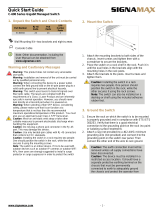
6 EX-3524/EX-3548 Layer 2 Gigabit Ethernet PoE/PoE+ Switch
1.3 Warnings
• Read all installation instructions and site survey reports, and verify correct equipment installation before
connecting the system to its power source.
• Remove jewelry and watches before installing this equipment.
• Verify any device connected to this unit is properly wired and grounded.
• Connect all power cords to a properly wired and grounded electrical circuit.
• Verify the electrical circuits have appropriate overload protection.
• There is a risk of explosion if the battery supplied with this product is replaced with an incorrect type of
battery. Dispose of used batteries according to the instructions.
•Use an Uninterruptible Power Supply (UPS) that supports the EX-3524/EX-3548 switch power rating. Not
using a UPS can result in data loss or equipment damage due to a power surge or power failure.
• Verify that the power connector and socket are accessible at all times during the operation of the
equipment.
• Do not work with power circuits in dimly lit spaces.
• Do not install this equipment or work with its power circuits during thunderstorms or other weather
conditions that could cause a power surge.
• Verify there is adequate ventilation around the device, and ambient temperatures meet equipment
operation specifications.
• This product is designed for in building installation only and is not intended to be connected to exposed
(outside plant) networks.
• This product uses lasers to transmit signals over fiber optic cable. The lasers are compliant with the
requirements of a Class 1 Laser Product and are inherently eye safe in normal operation. However, you
should never look directly at a transmit port when it is powered on.
• When selecting a fiber SFP device, considering safety, please make sure that it can function at a
temperature that is not less than the recommended maximum operational temperature of the product.
You must also use an approved Laser Class 1 SFP transceiver.
• Use only twisted-pair cables that conform to FCC standards with RJ-45 connectors.
1.4 Site Preparation
• Consult your site survey and network analysis reports to determine specific equipment placement, power
drops, and so on.
• Assign installation responsibility to the appropriate personnel.
• Identify where all installed components are located.
• Verify appropriate rack mounting requirements, as required.
• Provide a sufficient number of power drops for your equipment.
• Ensure adequate, dust-free ventilation to all installed equipment.
• Identify and prepare Ethernet and console port connections.
• Verify that cable lengths are within the maximum allowable distances for optimal signal transmission.
• Verify that the device is powered through an Uninterruptible Power Supply (UPS).




















